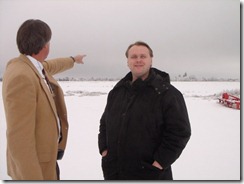I recently got an interesting note from Joel Stone, the Global Operations Chief at Global Switch. As some of you might know Joel used to run North American Operations for me at Microsoft. I guess he was digging through some old pictures and found this old photo of our initial site selection trip to Quincy, Washington.
As you can see, the open expanse of farmland behind me, ultimately became Microsoft’s showcase facilities in the Northwest. In fact you can even see some farm equipment just behind me. It got me reminiscing about that time and how exciting and horrifying that experience can be.
At the time Quincy, Washington was not much more than a small agricultural town, whose leaders did some very good things (infrastructurally speaking) and benefitted by the presence of large amounts of hydro-power. When we went there, there were no other active data centers for hundreds of miles, there were no other technology firms present, and discussions around locating a giant industrial-technology complex here seemed as foreign as landing on the moon might have sounded during World War Two.
Yet if you fast forward to today companies like Microsoft, Yahoo, Sabey, Intuit, and others have all located technology parks in this one time agricultural hub. Data Center Knowledge recently did an article on the impacts to Quincy.
Many people I speak to at conferences generally think that the site selection process is largely academic. Find the right intersection of a few key criteria and locate areas on a map that seem to fit those requirements. In fact, the site selection strategy that we employed took many different factors into consideration each with its own weight leading ultimately to a ‘heat map’ in which to investigate possible locations.
Even with some of the brightest minds, and substantial research being done, its interesting to me that ultimately the process breaks down into something I call ‘Kickin Dirt’. Those ivory tower exercises ultimately help you narrow down your decisions to a few locations, but the true value of the process is when you get out to the location itself and ‘kick the dirt around’. You get a feel for the infrastructure, local culture, and those hard to quantify factors that no modeling software can tell you.
Once you have gone out and kicked the dirt, its decision time. The decision you make, backed by all the data and process in the world, backed by personal experience of the locations in question, ultimately nets out to someone making a decision. My experience is that this is something that rarely works well if left up to committee. At some point someone needs the courage and conviction, and in some cases outright insanity to make the call.
If you are someone with this responsibility in your job today – Do your homework, Kick the Dirt, and make the best call you can.
To my friends in Quincy – You have come along way baby! Merry Christmas!
\Mm

Actually not true that there was no datacenters in the area. Yahoo had already completed a very well-publicized datacenter here in Wenatchee by the time Microsoft (and Yahoo’s second in Central Washington) had started in Quincy.
Ron,
Thats true. However, there is a VERY big difference (in technology and investment) between taking down space in an existing facility and siting one of the mega facilities that ultimately made the town of Quincy, well famous :). At least in Data Center Circles.
Mike
Wenatchee is not Quincy! A huge differences in population, focus, etc. Quincy is/was a very small town, beans and spuds…
Mike,
Nice commentary, especially, “Those ivory tower exercises ultimately help you narrow down your decisions to a few locations, but the true value of the process is when you get out to the location itself and ‘kick the dirt around’. ”
As a consultant who specializes in helping companies site new facilities, negotiate incentives and manage real estate transactions, I can also attest to the value of “field work”. It cannot be underestimated and it can certainly never be forsaken. It is an exercise with as many important nuances and “check lists” as the precursor of studying demographics, conducting cost comparisons and modeling geographies. Bravo for your observations.
JFK